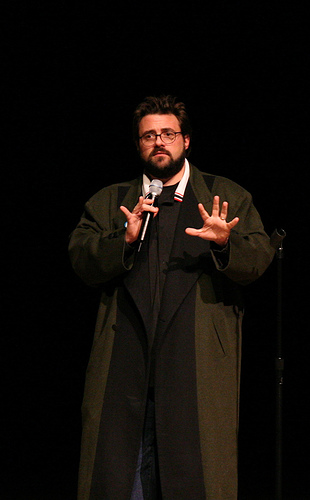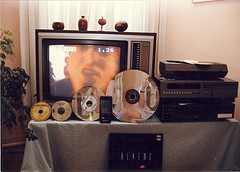I have the sinking feeling that I might be forced to define my terms….
My pal Aj alerted me to this boingboing post about the news that Pioneer is ending production of laserdisc players. The funny thing is, I honestly didn’t think Pioneer was still making laserdisc players.
That’s not a joke. Although I’ve been a fan of the format, and new players are still available, I was under the impression that whatever you can buy are just backstock from the early 2000s.
I’ve had a laserdisc player since 1993, and currently have a collection of around 100 discs. Similarly to my vinyl collection, I cleaned up buying used discs around ’97-’98 when DVD hit the market and the early adopter videophiles dumped their LD collections for the next big thing. In that crucial transition period there was quite a bit of debate amongst hardcore videophiles and home theater enthusiasts–a tiny population compared to today–about the comparative benefits and deficits of DVDs versus laserdisc.
Perhaps the most infamous salvo in that particular battle came from indie filmmaker Kevin Smith in the original commentary track to the Criterion laserdisc release of his second film, “Chasing Amy.” (Yes, commentary tracks first debuted on laserdiscs taking advantage of their discrete analog and digital audio tracks, and Criterion got it’s start on laserdisc.) Smith begins his commentary–recorded around 1997–with, “Fuck DVD.” Words I’m sure he had to live down in just a few year.Of course we now know that DVD soundly trounced laserdisc, which never grew past being a small cult format to begin with. While a lot of the late 90s debate sounded a lot like the analog vs. digital debate of the LP vs. CD argument, I think it’s safe to say that the relative charms of analog video in the form of laserdisc were not as alluring nor palpable as with vinyl records. I could go into a long dissertation on how that relates to the differences between audio and video recording (which is different than analog motion picture film), but I’ll spare you.
Unlike VHS, cassettes, LPs and photographic film, I think laserdisc is really dead. While the machines that record and play those other formats may be less widely available than in their heyday, you can still buy blank media and new player/recorders. With laserdisc it’s been a good eight years or so since a new laserdisc release has been commercially available. Furthermore, it was never a consumer-recordable format, so no recording your own discs. Without a commercially available program on laserdisc, the player isn’t much use.Now, there were thousand of movies and other programs released on laserdisc during the format’s 20+ year run, and there are still some films on laserdisc that have yet to see the light on DVD (though the number is dwindling). So if you have a decent laserdisc collection and a player, the format’s not dead to you.
But in the broader view, laserdisc must be declared a dead format . We won’t be seeing any new laserdisc releases, and I’d be surprised if there were any pressing plants still left in operation. Now there will be no more new players, when even enthusiasts like me thought they weren’t being made anyway.
By “dead” I mean that aside from whatever media you might already own, or what you might buy used, you will not see anything new coming on the format. Furthermore, you will soon be quite out of luck trying to find a new replacement player should you have one that dies — you’ll be forced to rely on the used market.
So, by this definition, I do think we can say formats like 8-track tape and Betamax are also dead. However, dead does not equal useless. So, if your laserdisc player, 8-track tape deck and Beta VCR still provide you with fun and pleasure, then there’s no reason to give them up, so long as you’re prepared to deal with the inevitable difficulties of relying on a dead technology. For some people, that challenge is a source of fun, learning how to creatively use media and machines that other people toss aside. It can also be a good way to amass a collection of classic albums or movies for pennies on the dollar.
But there it is highly unlikely there will be any growth or resurgence of laserdiscs, 8-tracks or Betamax. Although the death of vinyl, cassettes and film has been declared many times over in the last decade or two, at no point did the manufacture of new media (blank or prerecorded) or machines actually stop. Laserdiscs, my friends, quit being made available in the US eight years ago, while the distribution of pre-recorded VHS movies is only coming to a halt now.
Unlike folks who are still using their VHS VCRs, I don’t think there are any laserdisc owners who somehow think that the format is thriving. In fact, given that laserdisc was more of a high-end rather than mass-market item, I’d guess that nearly every current laserdisc user also owns a DVD player, and some have probably already upgraded to BluRay. That means they’re probably not being left behind on new movie releases unless they’ve made a very definitive choice not to upgrade to DVD.
Nevertheless, my position and advice on laserdisc is the same as VHS. If you have a laserdisc player and a collection of discs that you enjoy, there’s no reason to abandon them. For the most part I have not replaced any of my laserdisc movies with DVD versions–the extra expense isn’t worth it because the differences are minor. If your laserdisc player dies, then you have to weigh the hassle and cost of getting a replacement (new or used) versus the cost of getting your favorite movies on laserdisc replaced with DVDs.
Laserdisc was never a mainstream format. Despite Pioneer’s best efforts, outside of Japan it never caught on with the mainstream. Therefore, in my mind the consumer capitalist forces that forced its demise are less pernicious than when those attempting to force the obsolescence of something found in nearly every home, like LPs and VHS.
So, with that I must be willing to admit that laserdisc is dead, and long live laserdisc!



I totally agree about “dead media.” If you’re prepared for the inevitable time that you can’t repair or replace parts, then why get rid of it and “upgrade?” I still use VHS VCR’s, MiniDiscs, cassettes, and open reel (and vinyl.) The old adage comes to mind:
“If it aint’ broke, don’t fix it!”
Just wondering how many tv’s will be in the alley for garbage pickup the day after the DTV transition…